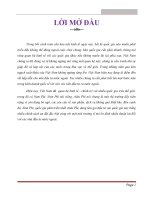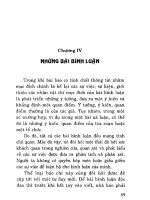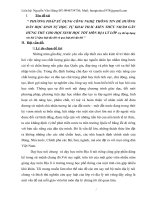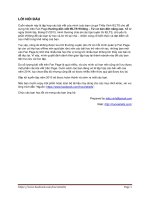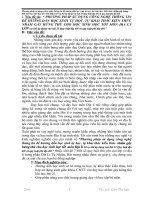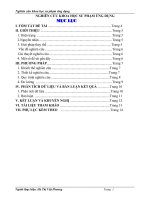Các kỹ năng để làm tốt bài thi toiec
Bạn đang xem bản rút gọn của tài liệu. Xem và tải ngay bản đầy đủ của tài liệu tại đây (164.47 KB, 17 trang )
Các Kỹ Năng Để Làm Tốt Bài Thi Toiec
A. Phần thi nghe
- Luyện kỹ năng nghe và phát triển vốn từ vựng là yếu tố cơ bản xuyên suốt tất cả các
bài nghe vì vậy ta sẽ nói về vấn đề phát triển kỹ năng nghe và từ vựng ở phần khác, ở
đây ta chỉ xét đến những kỹ năng để làm bài và chọn đáp án được xác suất đúng lớn
nhất.
1. Part 1
- Phần này kiểm tra chủ yếu vốn từ vựng và khả năng nghe hiểu của bạn, vì vậy để
nghe tốt phần này chỉ có một cách duy nhất là phải có một vốn từ vựng khá, và một
kỹ năng nghe tương đối tốt
- Ngoài ra kỹ năng xem trước hình ảnh là bước chuẩn bị quan trọng để chọn được đáp
án đúng. Bạn phải chuẩn bị trả lời trước một số câu hỏi có thể được hỏi trong hình
như:
+ trong hình là người hay vật
+ nếu có người trong hình thì xác định xem là mấy người
+ vị trí của người (vật) trong hình
+ ngoại cảnh trong hình(công viên, công trường, mái nhà, trạm xe bus, …)
+ hành động của người trong hình
+ tình trạng của vật trong hình
+ diện mạo bên ngoài của những người này, qua đó dự đoán về nghành nghề của
những người này
- Chú ý:
+ không bao giờ chọn những câu biểu thị trạng thái của người trong hình(vui, buồn,
dận dữ, thất vọng…), ví dụ bức hình biểu thị một người đang cười thì ta có thể chọn
đáp án là “người đó đang cười” không chọn đáp án “người đó đang rất vui” không
lấy biểu hiện bên ngoài đề suy diễn ra trạng thái cảm xúc bên trong.
+ không chọn những câu diễn ta một cách chung chung lấp lửng.
2. Part 2
- Kỹ năng cơ bản của phần này là:
+ luyện kỹ năng nghe theo loại câu hỏi, kết hợp với từ chính trong câu trả lời để tìm
mối liên hệ giữa trọng tâm câu hỏi và câu trả lời.
+ Một số câu hỏi dạng câu hỏi nâng cao, bạn phải biết kết hợp loại câu hỏi với thì và
chủ ngữ (đây là 2 bẫy phổ biến khi gặp câu hỏi cần sự kết hợp nhiều kỹ năng)
+ Ngoài ra, bạn có thể sử dụng kỹ năng phụ: repetion (sự lặp lại) để loại bớt đáp án
sai trong trường hợp không nghe được câu hỏi hay câu trả lời, lưu ý các dạng lặp
thường gặp là:
Lặp lại từ đồng âm: eg) supply – surprise sai
Lặp lại từ giống với từ trong câu hỏi (thường áp dụng cho danh từ và trạng từ,
đôi khi cũng có một vài trường hợp lặp động từ) sai
Lặp lại family words (từ gia đình hay họ từ): apply – application – applicant
sai
Sử dụng từ đồng nghĩa: deliver – send , come – arrive… đúng
Nhóm các câu hỏi cơ bản hay gặp.
a. Câu hỏi yes – no question, tag question (câu hỏi đuôi).
1
- Thường nhận câu trả lời là yes hoặc no (60%)
- Tuy nhiên, loại câu hỏi này có một số trường hợp trả lời đặc biệt
Actualy, in fact: thay cho yes – no thường
đúng.
I’m sure…/ (I think) you’er right…
It seems that way I believe…
It doesn’t seem that way Let me check…/check…
That way I’ve been told Ask (sb/name)… in charge of it
That’s way (sb) told… me (I think) sb/name…knows/has the infomation
That’s what (sb)… said Why don’t you ask (sb)…
It seem so/ it doesn’t seem so (did you) try…sb/place…
It doesn’t look that way
- Tránh chọn những câu trả lời có bẫy dạng: nobody…/no one…/no + noun không
phải là câu trả lời mang nghĩa “no”.
- Tránh chọn câu trả lời có chứa “also” hoặc “too” (là câu trả lời cho câu hỏi về ý kiến)
b. Câu hỏi “why”
- Thường nhận câu trả lời “because” nhưng trong các đề thi mới hiện nay thường
không chứa “because”. Do đó, bạn sẽ dùng một số kỹ năng khác:
+ Kỹ năng loại suy: loại các câu trả lời có trọng tâm khác với trọng tâm câu hỏi, tức
là nó dùng để trả lời cho câu hỏi khác (when, where, how, who…) các câu trả lời
dạng này thường được đưa ra để đánh lạc hướng.
Ví dụ: why did you come here?
a ) he came here yesterday.
b ) by bus.
c ) he forgot something in his office
đáp án đúng là đáp án c
+ Nên chọn câu trả lời có hàm nghĩa tiêu cực (chứa các từ: too, not, sorry, actually,
bad,…)
c. Câu hỏi lựa chọn “or”.
- Câu trả lời chọn 1 trong 2 ý A hoặc B
- Nếu có các câu trả lời đặc biệt sau đây thì phải ưu tiên chọn các câu trả lời này trước.
Either + is fine/would be fine It doesn’t matter
Neither of them Which one would you prefer?
Check with (sb, name)… Ask sb/name…
It depends…
d. Câu hỏi lựa chọn “Which”:
2
- Which + noun chọn câu trả lời có chứa: possessive (sở hữu), color (màu sắc),
comparison (so sánh), ordinal number (số thứ tự), place (nơi chốn), language (ngôn
ngữ).
Ví dụ: which book/version of Shakespear did you read? the one in French
Which car is Mr. bike’s? the blue one/the one by the front door.
e. Câu hỏi “what”.
Các câu hỏi thường gặp và các dạng trả lời của nó
Câu hỏi Câu trả lời thường gặp
What do you do? = what’s
your job?
Chọn công việc (job)
What excuse (for being
late)?
Traffic, tied up, flat tyre
What time = when
Câu trả lời: it’s…o’clock/a.m/p.m chỉ dành cho câu hỏi
what time is it?, không dùng cho các câu hỏi what time
khác.
What average profit? Câu hỏi về lợi nhuận chọn money/%
What index…?
Chọn câu trả lời có chứa “page”, “section”, “chapter”, các
từ này đồng nghĩa và có liên quan đến nhau, nếu trong câu
hỏi có chứa từ nào thì câu trả lời có thể chứa một trong số
các từ còn lại.
What name…?
Chọn câu trả lời có chứa name, hoặc câu trả lời đặc biệt “we
haven’t introduced”
What… attached/enclosed
with…?
Document, file, figure (con số)
What’s on calendar?
Câu hỏi này có ý = “what event will take place” chọn các
sự kiện: meeting, conference, talk, speed, seminar,
workshop, visit, presentation, music perfomance,…
What product image? Chọn câu trả lời có chứa tính từ
What product model?
Câu trả lời có chứa các từ: new version/line/prototype
(nguyên mẫu)/series
What refreshment…? Food/drink/snachs/coffee/tea…
What…like? = how…? Hỏi về vật gì hay ai đó như thế nào câu trả lời chứa (adj)
What kind/type of…? Chọn tùy theo danh từ đang được hỏi
What’s price/cost/fare of ? Hỏi về tiền “money” ( = how much).
What wrong with…? = what’s problem with chọn problem
What vacation /holiday…?
Hỏi về loại kỳ nghỉ/ du lịch nào? plane /train
/cruise/excursion /adventure /expedition (thám hiểm)…
Câu hỏi Câu trả lời thường gặp
3
What’s the fastest way
to…?
Chọn phương tiện di chuyển (bus /car /plane…)
What status of…? = how…
going on?
Hỏi về tình trạng công việc/ vật gì như thế nào? câu trả
lời có chứa “on schedule” hoặc có chứa tính từ (adj).
What… phone number?
Chọn phone number nếu có, không thì chọn câu có chứa
“telephone directory”.
f. Câu hỏi “who’s” và “whose”.
Chú ý phân biệt:
- Who’s the…? chọn câu có chứa đại từ chỉ người hoặc danh từ
- Whose + noun…? chọn câu trả lời thuộc dạng sở hữu (possessive) như: belong to,
own,… hay name’s
g. Câu hỏi “when”
Phân biệt
- When: hỏi về thời điểm (yesterday, next…, last…, on /at /in + time,…)
- How long = how much time: hỏi về khoảng thời gian (for /over /about…)
- How often: hỏi về mức độ thường xuyên (always, every, once /twice a week…)
When + V
ing
: mang hàm ý tương lai chọn câu trả lời có chứa future time
h. Câu hỏi “where”
- Where = what /which place /area.
- Câu hỏi where có dạng trực tiếp hay gián tiếp (khi hỏi đường).
Ví dụ: “where’s the bank?” có thể hỏi bằng cách khác.
Is there anywhere /any place I can exchage some money?
Is there any bank around /near here?
chọn câu trả lời có chứa địa điểm hoặc ưu tiên chọn câu trả lời đặc biệt nếu có:
+ here the guide book /map
+ let me chek the…
+ sorry I’m not from around here
+ I’m looking for it too
+ I’m new here
*** Lưu ý: các câu hỏi when, where, who đôi khi cả câu hỏi why và how sẽ có một số câu trả lời
đặc biệt, ưu tiên chọn các câu trả lời này nếu có:
Check + place Why don’t you ask (sb /name)…
Let me check… (sb /name) probably /may know
Check with + person I think (sb /name)… has the information
Ask (sb, name)… in charge of it Have you try/ tried…
i. Câu hỏi “how”
- Các dạng thường gặp
4
How long = how much time…? hỏi khoảng thời gian (for, about, since)
How long ago khoảng thời gian + ago
thời điểm (= when)
How fast hỏi tốc độ (km/h, word/minute…)
How do you pay for…? cash /credit card…
How often: hỏi về mức độ thường xuyên
How far: hỏi về khoảng cách (mine, meter, block (dãy nhà), kilometer…), đôi khi
người ta dùng thời gian để trả lời cho câu hỏi này:
Ví dụ: how far is it to the museum?
It’s a five – minute walk
It’s a 45 minute drive
How come = why
How much money hoặc “it’s on me”
How many số lượng
How heavy weight
- Ngoài các dạng thường này, còn một số dạng câu hỏi khó khác:
+ phương tiện di chuyển: how did you get here? by bus /car…
+ phương tiện liên lạc: how will I reach you? by phone /email…
+ cách làm hay hướng dẫn sử dụng (instruction /ways to do things) :
Ví dụ: how can I operate this machine?
chọn các câu trả lời có chứa:
It’s easy, I’ll show you
(don’t worry) I’ll explain to you
(sb) knows how to use it
(sb)… can help you…
Just + V (just put /press this button)
+ ý kiến /đánh giá (opinion) how do you feel about…? chọn câu trả lời có chứa
tính từ hoặc các từ chỉ cảm xúc (enjoy, love, like, hate, don’t like, dislike…)
Nhóm các câu hỏi giao tiếp:
- Bạn cần học thuộc các mẫu câu và các mẫu đối thoại trong giao tiếp hằng ngày
a. Câu đề nghị (suggestion)
Các mẫu câu hỏi và câu trả lời thường gặp.
Các mẫu câu hỏi thường gặp
Why don’t we /you…? How do you feel about + Ving ?
Should we /shouldn’t we…? Shall we…?
5
(I think) we should… Are you interested in + Ving…?
Let’s…
How about + Ving…?
What about + Ving…?
Các câu trả lời thường gặp
Câu trả lời đồng ý
Sure /I have you, yes /certainly và có thể
đi kèm với các câu sau.
I’d love to /I’d rather /I’d be glad to
That’s a good idea I suppose I’d better…/I’d appreciate
That sounds great /interesting /nice… Let’s… /that will be fine
That would be a nice gesture
Câu trả lời mang nghĩa không đồng ý
I don’t think should… Actually, I have other plan
I’m sorry /afraid, but I’m busy then… I’d love /like to but…
b. Câu mời (invitation):
Các câu hỏi thường gặp
Would you like…? If you’d like,…
Would you care for…? Are you interested in + Ving
Do you want (me) to…? Will /shall I …for you…?
If you need /want /interested in /…, I’ll…
/you can…
We were/I was wondering if you’d like
to…?
Các câu trả lời thường gặp
Câu trả lời đồng ý
Sure /thank, yes /certainly đi kèm với các
câu sau
I’d love to /I’d be happy to /I’d be glad to
That’s very nice /sweet /kind of you I’d appreciate it (very much)
That sounds nice /fun /… Thank for inviting
Câu trả lời mang nghĩa không đồng ý
I don’t think should… I’d love /like to but…
I’m sorry /afraid I can’t, I …(have an
busy /appoitment…
No, thanks I can deal with them / I have
arranged it.
c. Câu đề nghị giúp đỡ người khác (offer).
Các câu hỏi thường gặp
6
Would you like me to…? Do you need…?
Would you like a hand with…? Should you need help, please…?
I’d happy to … for you? Will /shall I …?
- Câu trả lời được đưa ra giống phần b.
d. Câu yêu cầu (request)
- Các câu hỏi thường gặp:
+ can /could you …?
+ would you please…?
+ will you…?
- Câu trả lời:
+ mang nghĩa đồng ý:
Sure /yes /certainly /of course + kèm theo các câu
< it’s my pleasure /job
< that’s no problem
< that what I’m here for
< I’ll take care of it
< I’ve already done it.
+ mang nghĩa không đồng ý:
I’m sorry /afraid I can’t /I’m busy /I …
e. Câu xin phép
- May/ can/ could I … hoặc is it ok if I …
Đồng ý: sure/ yes/ of course/ go ahead/ please do/ certainly
Không đồng ý: I’m sorry/ afraid…
f. Các loại câu khác:
- Would you mind + Ving
Đồng ý:
+ no, not at all /no problem
+ no, it’s my pleasure
Không đồng ý: sorry, but…
- Would it be ok if…? + đồng ý: sure /yes that’s fine
+ không đồng ý: sorry…
- May I sit down? Hoặc excuseme! Is this chair /seat availble?
Đồng ý: + please, do
+ no, please sit down
Không đồng ý: I’m sorry /afraid it’s occupied
- Have /has …yet /already /before ? (đã xong rồi hay chưa) câu trả lời có thể có hoặc
không có yes /no nhưng thường có thời gian ((yes /no) + time).
- Do you think…?
Don’t you think…
I don’t think…
I think…
Câu hỏi ý kiến đánh giá, thường có câu trả lời thể hiện sự đồng ý:
+ yes, that’s right
7
+ may be you’re right
+ I gree
+ it seems that way
+ it seem so
+ that’s what I was thinking
- Did … come /arrive …yet? Câu trả lời ưu tiên là yes /no + place
Ví dụ: did the mail I ordered come yet? (yes), it’s on your desk
- (sorry) I didn’t hear your question /what you said
Pardon me! I can’t cacth your words
câu hỏi yêu cầu lặp lại chọn câu trả lời có ý lặp lại
+ I said…(I’m leaving soon)…
+ I ask… (what you did last week)
- Did I receive /have any message? Hoặc “did any call when I was out?” (yes), your
wife /doctor… called hoặc there’s a message for you on your desk.
- (sb /name) called when you were out.
Thanks I’ll call … back later
Do you know who it was?
Did … leave any message?
Tell … I’ll call … back
- I can’t find…
I’m looking for…
câu trả lời hàm ý chỉ nơi chốn (place)
- May /can /could I talk /speak to…?
Sorry,… not in right now. Can I take a message?
(hold on) I’ll conect you with (sb)…
I’ll put you through to … (sb)…
- Who can help with chọn câu trả lời có dạng:
+ I think …sb…can do it
+ I’m going to be free…
+ I’ll to happy /glad to…
*** Chú ý: dạng câu “I don’t know”. Đây là câu trả lời đặc biệt luôn đúng trong mọi trường hợp
kể cả câu hỏi “Wh – question”, “câu hỏi “or” và câu hỏi “yes /no – question”. Chúng chỉ không
sử dụng được trong các câu suggestion, invitation, offer, xin phép ở phần câu giao tiếp.
Một số dạng hay gặp của “I don’t know” là:
I don’t really know
There hasn’t been any decision
/announcement
I have no idea They didn’t say anything about…
How come /would I know? We are not quite sure yet
It hasn’t been decided /anounced Beats me
I can’t tell you for sure no I’m not quite sure about it
I haven’t heard /read of it
8
Các dạng liên kết theo nghĩa phổ biến giữa câu hỏi và câu trả lời:
Cold
+ Turn of the airconditional
+ turn on the heart
+ close the door
+ wear warm clothes /sweater /coat
Hot
+ open the window /door
+ turn on air conditioner
+ turn on the fan
+ go swimming
rainy Wet weather, coat, umbrella, boots…
Flight, train, trip to (place) Cancel, delay, postpone
Why cancel trip /flight /train/ …to…?
+ bad weather
+ deal /plan fell through
+ ice on the track (train)
+ runway is busy (plane)
Haven’t seen (sb /name) in office today
+ call in sick
+ meet client
+ at /in a meeting /conference
Confirm date
Book /reserve room /party
Date /time + reservation /appoiterment
Business trip Meeting /conference
Why flight /trip to…? (mục đích của
chuyến du lịch)
+ for pleasure
+ on business /holiday /vacation
+ to visit sb…
Go out of business (phá sản)
+ no choice /option
+ sorry to hear that
Due out Chọn thời gian ở tương lai
Interest rate
+ change
+ increase /decrease
economy
Improve, growing, go up, go down,
decline(giảm)
Car broken /repair Do you want a lift /ride
Elevator /lift broken (thang máy hư) Take stairs (đi thang bộ)
Machine /photocopier broken again Get a new one /repair
Shoe /shirt too tight /small (chật, nhỏ) Get a new one /a larger size
I’m nervous /worried…
Don’t worry /I’m sure /calm down + you
will be fine /you will be doing fine
Get along /delicious Like, love, enjoy
9
Hungry /starring Eat…, restaurant…, snacks…
rain
Coat /rain coat /umbrella
Take taxi
Stay home
Not good for beach/ vacation/ picnic
Sb/ name’s plane/train comes/came … at +
time
Pick up/see/meet at airport/station
Cloudy sky Rain
snown Skiing
Not enough money/ no money/ forget my
purse/ wallet
Shall/ will I lend you some money
Can you recommend…a doctor/ hotel/
dentist/ restaurant…
Name, place
Leave work early Sick/ ill
*** Ngoài ra bạn cần lưu ý một số điểm sau để bổ trợ kỹ năng nghe
- Sử dụng thêm kỹ năng lặp lại
- Luôn chọn ưu tiên cho các câu trả lời ngắn cho các câu hỏi “Wh-question”
Ví dụ: hỏi where chọn at/ in/ on + place tránh chọn S+ V + at/ in/ on + place (vì
dạng câu này thường sẽ có bấy chủ từ hoặc thì của động từ).
- Chọn theo trọng tâm của câu hỏi và câu trả lời. dùng kỹ năng loại suy để loại các câu
không đúng trọng tâm để tìm ra câu có xác suất đúng cao nhất (thường trong trường
hợp mà bạn không nghe được câu đúng)
3. Part 3.
a. Các dạng câu hoặc từ thay thế thường gặp.
Câu hoặc từ có thể gặp Dạng thay thế thường dùng
Change the meeting time Reschedule
popular
+ Many people interested in/ enjoyed
+ Top of the chart
Shut down/ closing Go out of business
Paper/ a sheet of paper Paper work/ document/ form
Clarify (làm rõ)/ verify (xác nhận)
Make sure…/ I’m not sure…/ I want to check…/
I’m afraid I don’t understand…
Approve/ approvement (sự phê
duyệt)
Permission
Pass along the message to…
+ deliver the information to…
+ send the information/ message to…
Financial problem Money/ lack of money/ short of money/ budget
10
fix Repair
plane Flight/ air away/ air line
Bill Receip
secretary Assistant/ clerk
Out of order (hư/ hỏng) Not working
Financial institution (tổ chứ tài
chính)
Bank
discount
At a lower/ cheaper price
On sale/ on % off/ speacial offer
Every day/ week … On a daily/ weekly…
Every 2 weeks biweekly
Every 2 years Biannualy
Every year annual
Emergence (case) Urgent
Forget st Slip one’s mind
walk On foot
b. Các dạng câu hỏi – tình huống – kiểu bài thường gặp.
Câu hỏi Mẫu câu trả lời
Why unable to fix the car
+ Delay in shipment (giao hàng trễ)
+ not arrive on time = arrive late
+ Hope to come on time, but …untill (time)
What’s the purpose of the call/
message?
I’m calling to inform/ confirm/ remind…
I’m returning your call
We/ I would like to…
How man/ woman get to the…?
Thường sẽ chọn 1 trong 2 trường hợp:
+ walking/ on foot/ it’s a 10 minute walk
+ by taxi/ car driving, ride, lift
+ it close enough to walk to, so I won’t have to
drive
What’s the problem of the party?
Why was the trip cancel?
Thường có câu trả lời là “bad weather” nhưng đề
khó sẽ phải suy luận lý do này từ các gợi ý: heavy
rain, tornado, storm, strong winds, …
Lúc này sẽ có sự thay đổi giờ bay (flight time) hoặc
địa điểm tổ chức tiệc (where to hold party) thì câu
hỏi thường đi kèm là “where/ when was the
flight/party originally (lúc đầu) scheduled?” nghe
các cấu trúc originally planed for/ at (*)
11
changed/ move from (*) to (*) instead of (*)
(*) : là các đáp án chọn cho câu hỏi này.
How… man/woman…pay? (hỏi
về cách thanh toán)
arg
dollar bill
cash
ch e
→
Charge to account credit card
What… man/woman doing now?
Let me finish (*) first
If…, we have to get this done first
(*) not finished/ don’t yet
(*) is nearly done/finished
Với (*) là đáp án
Looking for/ offering a job
Resume/ application for/ hiring/ interview/
employment, opportunity.
- Câu hỏi “where” là câu hỏi suy luận thường gặp. bạn cần biết các “key words”
thường dùng để hàm ý chỉ nơi được hỏi.
restaurant
Menu, ready to order, drink, beverage (đồ uống), waiter,
starter, dessert,…
hotel
Check-in, room key, number room, mini bar, make
reservation, book online,…
conference Speaker, speech, presentation, session (buổi họp)
Banquet hall (phòng tiệc)
Catering staff (nhân viên phục vụ), refresh,
complimentary(miễn phí), luncheon (bữa trưa)
Store Aisle (gian hàng), counter, pay by cash/ credit card.
On the plane
Overhead bin, seatbelt (dây an toàn), captain, flight,
attendant(tiếp viên).
On the airport
Baggage, luggage, passport control, boarding, ready to board,
gate attendant
Art gallery Oil pain, water color, drawing, painting
photography Studio, photos, camera, taking picture
Phân biệt giữa plane và
train:
air / air
/
plane line passenger
train rail passenger track
→
→
Phân biệt giữa plane/
train và restauran/ store/
hotel:
/
/ /
plane train passenger
restauran store hotel customer
→
→
At a grocery (cửa hàng
tạp hóa)
Vegetable, soup
Café, cafeteria Drink, coffee, beverage
12
Travel agency
Tourism, travel company, tour, trip, reserve, book a ticket
to…
- Câu hỏi “who” cũng là câu hỏi suy luận thường gặp:
scientist Industrial, research, machinery (máy móc),…
physician = doctor
dentist = doctor + teeth cleaning
Surgeon (bác sỹ phẫu
thuật)
= doctor + operation/ surgery (phẫu thuật)
Boss/ manager
Chú ý nghe các câu:
I want to talk to you…in office
I’ve been unhappy with your performance
…come and see me in my office
Employee/ co-work
Did the bog boss know?
Have you told the manager about…?
Assistant/ secretary/
clerk/ receptionist
May I help you?
What can I do for you?
How may I be helpful to you?
Teacher/ professor University, student, exam, text book…
mechanic Fix, repair, test pipes (ống nghiệm)
Tour guide
Welcome…to bus tour/ on this tour, we will visit…/ on our
left/right of…/ to the west/east of…
Salesperson/
representative
New product, discount, price…
4. Part 4
- Các dạng bài và câu hỏi thường gặp:
a. Weather report:
- What kind of weather is it now?
Summer hot, heat, high temperature
Winter cold, snow, blizzard, freezing
Rainy wet weather, humid, a drop in temperature, low temperature.
- What can people look forward to this weekend? câu hỏi này phải hiểu “weekend”
là cả “Saturday” và “Sunday”.
- When will it get colder?
At night after the sun goes down
Over night tomorrow
At weekend ưu tiên chọn “Saturday” nếu ko thì chọn “Sunday”.
- What are listener suggested/advised to do? (lời khuyên/ đê nghị đến người nghe) =
what does the speaker suggest people (should) do?
Hot take enough water, stay in door, stay in the house
Cold wear farm/jacket clothes/gadgets
Snow, fog (sương mù) drive carefully
13
- Who is the speaker? weather reporter/man
- What will listener to do next? câu này tùy theo đề có thể hỏi hoặc không, nhưng
nếu có hỏi, bạn luôn nghe câu cuối “…and now is the time for (*)
b. Traffic advisory
- Where announcement…take place? (thông báo này diễn ra ở đâu) nghe giống câu
hỏi where ở part 3
- What causes the road/street damage? bad weather
- What causes the closure of the road/street? damage by bad weather/ accident
→
congesion/ traffic jam (kẹt xe)
- Slution: street/ road is closed from (time) to (time)
→
take a detour (đi đường vòng)/
find alternate route/road (tìm đường thay thế)
- What are listener asked to do?
→
drive carefully.
- Who is this announcement noticed for?
→
car drivers
- How can listener get more info?
→
stay turn (radio) for more info/ get more updates
in local newspaper
c. Announcement of train/ flight delay:
- Where
→
giống part 3
- Why is there a delay?
Flight: bad weather, run away, low bargain
Train: bad weather (rain, storm, fog, strong wind…), frozen track,…
- What listener asked to do?
Discuss alternate arrangements
Get meal vouchers, free accommodation (chỗ ở miễn phí) (for ticketed
passenger)
d. Plane taking off/ landing announcement (thông báo hạ cánh)
- Who is speaking?
→
captain
- Destination (điểm đến)
→
bound for /heading for + place
- Where originate (chuyến bay bắt đầu từ đâu)
Originate in + place
From (place) to (place)
- What kind of flight?
Direct/ non – stop flight (không quá cảnh)
Flight with stoppover in/ conection to + place (quá cảnh ở…)
- What are passenger asked to do?
Watch a safety video
Stay seated
Keep seatbelt on
Turn off all electronic devices
- When passengers resume their activities ? (khi nào hành khách có thể hoạt động trở
lại)
The will be an announcement when these activities can be resumed
14
- What are flight attendants going to do?
→
serve drink, beverage, snacks, …
e. Travel/ tour itinerary (hành trình chuyến du lịch)
ở dạng bài này thường có các câu hỏi chi tiết về thứ tự của chuyến đi, nên bạn cần
tập trung nghe các mốc thời gian.
- Right after the tour…, folowing…, before…
- Who is speaking?
→
tour guide
- What kind of tour?
→
bus, train, city.
- What are the people reminded to do?
Not venture out alone
Stay in pairs/ groups
Take photos of wildlife/ animals, plans…(there are plenty of photo
opportunities for…with )
- Where are the people standing?/ speaker?
→
this, back, here…(giống part 3).
f. Announcement of upcoming event (thông báo về sự kiện sắp tới)
- Who is the speaker?/ audience?
→
đây là câu hỏi ở phần 4, tùy thuộc vào loại bài và
tình huống mà chọn câu trả lời, thương bạn sẽ nghe đáp án hoặc đoán được đáp án
thông qua lời chào (greeting), welcome, … hoặc cách xưng hô của người nói với
người nghe
→
thông tin này sẽ nằm ở đầu bài nói.
- What is the event?
- Where is the event being held?
- How many paticipants?
→
chú ý cách nói theo ước lượng % (two third, half, one
third)
- Who is the invited guests/ speaker?
- What is the speaker going to do next?
- What is the audience going to do next?
- What is the audience asked to do?
g. Announcement of public performance (thông báo về việc công diễn) (museum,
theater, cinema, opera…)
- Who is the audience
→
giống phần f
- Where?
→
giống part 3
- Why audience not allowed to take photos
→
performance being tapped/ recorded/
live broadcast (truyền hình trực tiếp)
- What audience asked to do?
Turn off the cellphone
Not take photo/ use camera
Not taking/ making noise
h. Announcement of big sale/ discount
- Why is there the big sale/ discount
→
store out of business/ going to close/ shut
down
15
- Opening hours:
→
from (time) to (time)
- How much is discount?
→
Half price, 50% off…
- How long is the discount/ sale?
i. Introdution of new employee/ staff
- What is the main purpose?
→
to introduce a new…
- What is the new … position?
- What company is the new … going to
+ 3 câu hỏi này thường nằm ở đầu bài nói, sau lời chào.
+ sau đó người nói sẽ giới thiệu về nhân viên mới
Where worked before (lịch sử làm việc)
Experience (kinh nghiệm)
- Who is listening?
→
tùy vào câu chào và cách xưng hô, nhưng thường sẽ chọn
→
employees, company staff.
- When will the chage take place
- How are other employees asked to assist the new…?
Tour around the company
Tell about local area
Give needed information
j. Advertisement
- Who is the advertisement intended for? (quảng cáo này hướng tới ai)
→
câu này
thường nằm ở phần đầu bài
→
obese people, people who are …
- What is being advertised?
- What makes this product different?
→
câu này được nhắc đến ở phần tính năng của
sản phẩm, sau khi nói đến sản phẩm gì đang được quảng cáo
- Discount information: giá cả và giảm giá, thời gian ưu tiên giảm giá
- Contact
→
liên hệ đặt hàng
→
đa số các câu hỏi ở bài này là câu hỏi về chi tiết nên bạn chỉ cần nghe keyword.
k. Announcement of company policy chage (thông báo về sự thay đổi trong công ty)
Dạng bài này cũng chỉ hỏi các câu hỏi chi tiết
→
nghe theo keyword.
Các dạng thay đổi thường gặp:
- Computer system
- Email system
- Sick leave policy
- Parking system
- Recycling method/ system
Có 2 câu hỏi suy luận có thể có
- Who is speaking?
→
manager/ boss
- Who is the audience
→
employees/ company staffs.
16
l. Announcement of a merger (thông báo về sự sáp nhập, hoặc công ty lớn mua công
ty nhỏ)
- When merger?
- What is the attitude of speaker?
→
don’t like/ hope not happen
- What happened after the deal/ news took place? (câu này thường gặp): điều gì xảy ra
sau thỏa thuận.
Value of company rose/ increased
Company share/stock value rose/increased/fell/decreased/stayed the
same/unchage.
** chú ý: đối với các câu hỏi “who”, bạn nên chú ý nghe cách xưng hô, lời chào của người nói từ
đầu bài. Đối với đề khó, đôi khi bạn phải suy luận “who are listeners?” dựa vào topic (đề bài) mà
người nói nhắc đến
kết thúc phần nghe
chúc các bạn thi tốt
(bài viết được tổng hợp từ nhiều nguồn)
17



